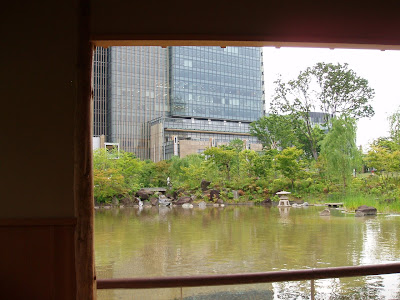During the past one year, the most dramatically transformed area of Tokyo is Ginza.
First off, I visit Marronnier Gate, opened on September 1, 2007. This 12-story shopping and dining complex surprises me in two senses. First, each of the top three floors for dining features different types of cuisine: the 10th floor for European, the 11th for Asian, and the 12th for Japanese. I'm not aware of any other buildings in Tokyo that organize their restaurants in this way, but it makes real sense. You usually feel like eating a particular type of cuisine, so you don't want to browse Japanese, Chinese, and Italian restaurants together around, do you?
Among the Japanese restaurants on the 12th floor, I try Sou, serving vegetable dishes from Kyoto with stylish decor of Japanese minimalism. My choice is "One Soup Three Vegetables", a lunch menu available only on weekdays. The vegetable soup with white miso in Kyoto style is superb. The price is just 1,500 yen (9.3 euro). By Tokyo standards, this is not cheap for lunch. But neither London nor Stockholm manages to serve a lunch dish that can be described as "superb" for this price.
Downstairs, Tokyu Hands occupies five floors from the 5th to the 9th of the Marronier Gate. Tokyu Hands is a well-established chain for homeware and DIY goods, sometimes selling quirky stuff. But it's never associated itself with style. In its newly opened Ginza branch, that's not the case anymore. It signifies the recent change in trend in Tokyo towards a better quality of life.
Walking on Marronier Street to the east from the Marronier Gate, you'll see De Beer's first store in Asia, opened on March 20, 2008. Just have a look at its wavy facade:


A further change to Ginza's landscape is Swarovski's flagship store, the first for the brand, on Chuou Dori (Central Street). Opened on April 1, 2008, Tokujin Yoshioka designed the store interior under the theme of crystal forests.
Ginza has also seen Giorgio Armani, Cartier, Bvlgari, and Dunhill open or renew its flagship store during the past one year, and they are not just another store in this world. They feature good design and something only available in Tokyo.
Nowadays, anything that is hyped or proves to be popular in the West comes to Tokyo. H&M will finally open its first store in Japan, again in Ginza, this September. Channel's much-hyped mobile art exhibition comes to Tokyo at the end of this month, before any European cities (but after Hong Kong). Plus Tokyo offers great and inexpensive eating-out experiences and excellent services even at budget stores, both of which are unthinkable in the West. What is the reason for not living in Tokyo?




































